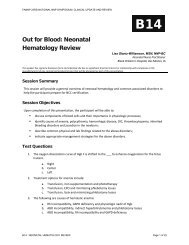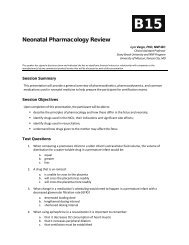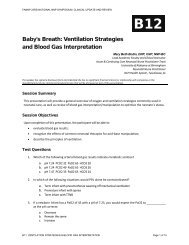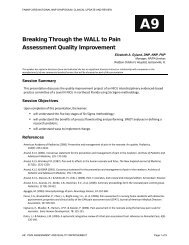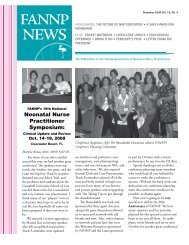Differential Diagnosis and Management of Respiratory ... - FANNP
Differential Diagnosis and Management of Respiratory ... - FANNP
Differential Diagnosis and Management of Respiratory ... - FANNP
You also want an ePaper? Increase the reach of your titles
YUMPU automatically turns print PDFs into web optimized ePapers that Google loves.
<strong>FANNP</strong> 23RD NATIONAL NNP SYMPOSIUM: CLINICAL UPDATE AND REVIEW<br />
Laboratory Studies<br />
Radiography<br />
• ABG: initially see hypoxemia. Prolonged hypoxemia<br />
can lead to metabolic acidosis due to the presence <strong>of</strong><br />
anaerobic metabolism. No longer recommended to<br />
treat with hyperventilation.<br />
• CBC: Polycythemia <strong>and</strong> hyperviscosity may be a<br />
predisposing factor in some cases.<br />
Thrombocytopenia has been reported in as many as<br />
60% <strong>of</strong> cases - unknown etiology. R/O sepsis.<br />
• Basic metabolic pr<strong>of</strong>ile: PPHN is sometimes<br />
associated with hypoglycemia or hypocalcemia.<br />
*Calcium is a critical c<strong>of</strong>actor for nitric oxide<br />
synthesis activity.<br />
• Chest x-ray appearance will be related to the<br />
etiology <strong>of</strong> the PPHN ( For example, MAS, CDH,<br />
pneumonia).<br />
• Without associated pulmonary disease, there will be<br />
decreased pulmonary vascularity due to diminished<br />
pulmonary blood flow.<br />
• Cardiac shadow will reflect degree <strong>of</strong> cardiac<br />
involvement (Congenital heart disease?)<br />
• Clear lung fields in the presence <strong>of</strong> severe<br />
hypoxemia is highly suggestive <strong>of</strong> PPHN if cyanotic<br />
CHD has been ruled out.<br />
97<br />
98<br />
Echocardiogram<br />
<strong>Differential</strong> Blood Gas Results<br />
• Normal cardiac anatomy<br />
• R to L shunting through ductus<br />
arteriosus or across the foramen<br />
ovale<br />
• In the presence <strong>of</strong> R to L shunting via the PDA, the<br />
PaO2 will be higher in a pre-ductal site than from a<br />
post-ductal site.<br />
• Pre-ductal = right radial artery (right arm <strong>and</strong> head)<br />
• Post-ductal = left radial artery, umbilical artery,<br />
posterior tibial arteries (left arm, umbilical artery<br />
<strong>and</strong> lower extremities)<br />
• A difference > 10 mm Hg between pre <strong>and</strong> post-ductal<br />
PaO2 suggestive <strong>of</strong> R to L shunt.<br />
99<br />
100<br />
<strong>Differential</strong> Pulse Oximetry<br />
<strong>Management</strong><br />
• Simultaneous monitoring <strong>of</strong> oxygen saturation via<br />
pulse oximeter (SpO2) is a useful indicator <strong>of</strong> R to L<br />
shunting at the ductal level.<br />
• SpO2 difference > 5% is suggestive <strong>of</strong> R to L shunt<br />
via the PDA.<br />
• No difference will not rule out PPHN however.<br />
• Treat the underlying condition if known.<br />
• Minimal h<strong>and</strong>ling.<br />
• Avoid hypovolemia.<br />
• Monitor serum glucose <strong>and</strong> calcium.<br />
• Mechanical ventilation.<br />
• Medications<br />
• ECMO<br />
101<br />
102<br />
B07: MANAGEMENT OF RESPIRATORY DISTRESS Page 19 <strong>of</strong> 23



